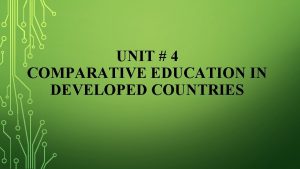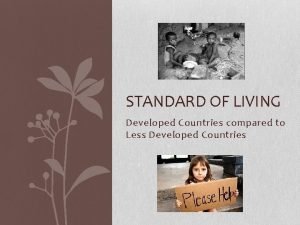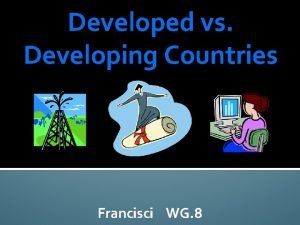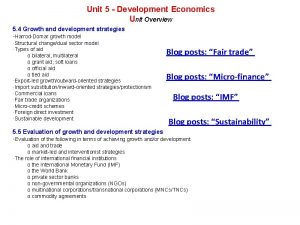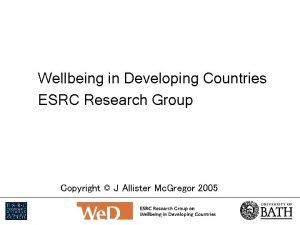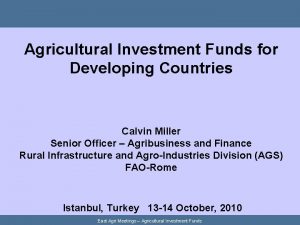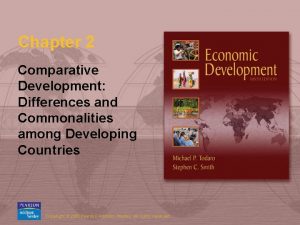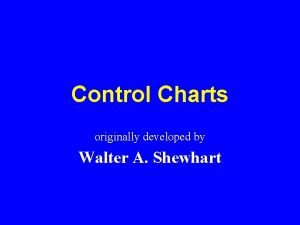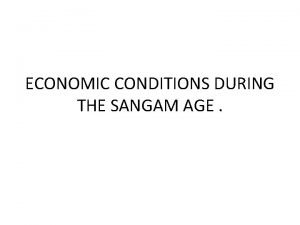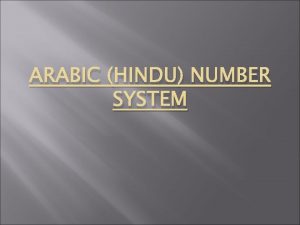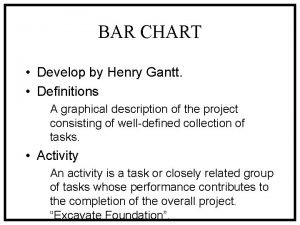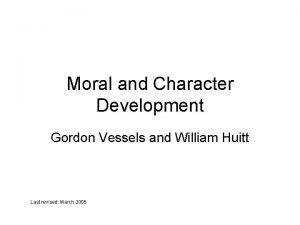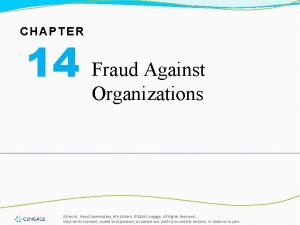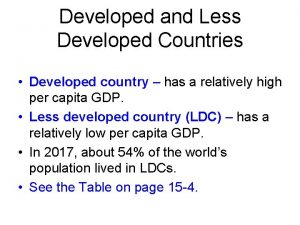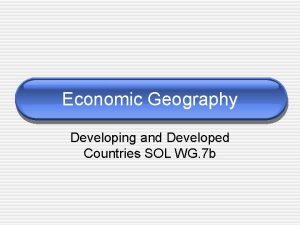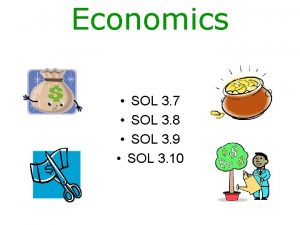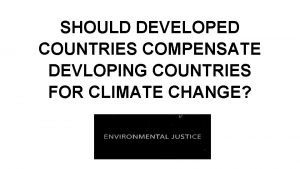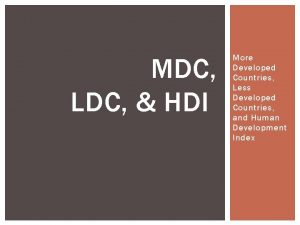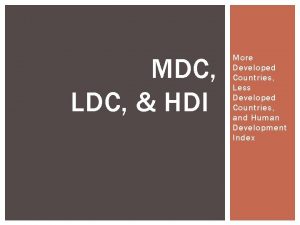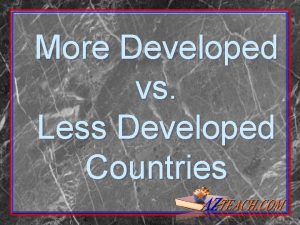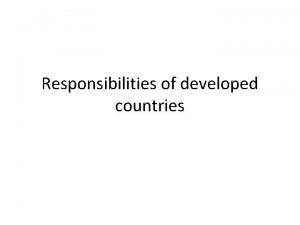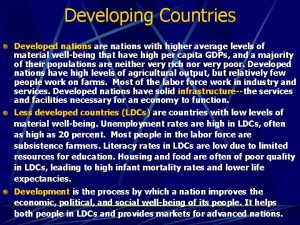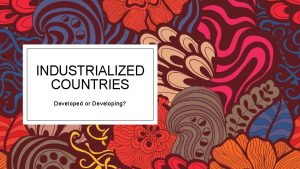SOL 8 Developed vs Developing Countries What are






















- Slides: 22

SOL 8 Developed vs. Developing Countries

What are the differences between developing and developed nations? ? ?

1. Access to capital resources (investments) • Technology (internet, etc. ) • Infrastructure – communication systems, road systems, health services, energy production, waste disposal, airports, utilities, food distribution, water treatment

2. Human resources (labor or workers) • Well educated and highly skilled workers vs. poorly trained, low skilled workers

3. Levels of economic development • Gross domestic product (GDP) – income of a country for a year • Per capita income – average income person for a year

4. Population distribution • Where people live at – in urban or rural areas

5. Labor force characteristics • Primary sector – gathering natural resources • Secondary sector – manufacturing or assembly • Tertiary sector – service industry

6. Educational achievement • How much formal education do people have

7. Availability of natural resources • Availability of natural resources (such as water, oil, and natural gas)

• Levels of economic development vary from country to country and from place to place within countries. • Many criteria are used to assess the standard of living and quality of life.

Indicators of standards of living and quality of life

1. Population growth rate (natural increase) • Developed countries – Population increase is moderate to low • Developing countries – Population increase is usually very high

2. population age distribution (population pyramid) • Developed countries – Population evenly distributed between age groups or an older population with fewer young people • Developing countries – Population usually consists of large numbers of young people (often 14 or younger) – Many people do not live to be very old and the birthrate is high

3. Literacy rate (% of population that can read and write) • Developed countries – 90% or more • Developing countries – 50% or less

4. Life expectancy ( avg number of years a person is expected to live) • Developed – Between 75 – 80 yrs • Developing – Between 50 – 60 yrs (could be younger)

5. Infant mortality (avg number of babies that die during their first year, per 1000 births) • Developed – Excellent health care, few babies die • Developing – Poor health care, many babies die

6. Percentage of urban (city) population • Developed – High % live in urban areas • Developing – High % live in rural areas

7. Type of agriculture • Developed – Commercial agriculture – Raising cash crops (to be sold) • Developing – Subsistence agriculture – Raising enough food to survive

8. Percentage of population involved in agriculture • Developed – Low • Developing – high

According to the chart above, which country has the least number of people working in the area of agriculture? Country A Country B Country C Country D

Literacy Rates (%) 52 33 Country 38 57 38 72 Pakistan Nigeria Liberia Iran 36 51 Guinea Egypt Literacy Rates c. 1990’s Togo Senegal • Which nations would seem to have the highest standards of living? • Egypt, Iran, Togo • Egypt, Iran, Nigeria • Iran, Nigeria, Togo • Iran, Nigeria, Pakistan

Country Life Literacy Expect. Rate ancy * % of Workers in Agriculture ** % Urban Pop. Per Capita GDP *** • Malaysia 71 93% 21% 53% $11, 000 • Philippines 66 95% 43% 54% $3, 200 • Singapore 78 91% 1% or less 100% $24, 600 • South Korea 74 98% 21% 61% $13, 700 *age 15 and over **includes fishing and forestry ***U. S. dollars (purchasing power parity— 1997 est. ) Which country would be considered developed?
 Antigentest åre
Antigentest åre Comparative education in developed countries
Comparative education in developed countries Mdc more developed countries
Mdc more developed countries Less developed countries
Less developed countries Developing nation definition
Developing nation definition Harrod domar growth model
Harrod domar growth model Harrod domar growth model
Harrod domar growth model Esrc wellbeing in developing countries que es
Esrc wellbeing in developing countries que es Difference between developing and underdeveloped countries
Difference between developing and underdeveloped countries Agricultural investment funds for developing countries
Agricultural investment funds for developing countries Major characteristics of developing countries
Major characteristics of developing countries Perbedaan sol liofil dan sol liofob
Perbedaan sol liofil dan sol liofob Who developed control chart
Who developed control chart Sunken screen evaporimeter
Sunken screen evaporimeter Agriculture sangam was developed in
Agriculture sangam was developed in Arbitrage pricing theory exercises
Arbitrage pricing theory exercises Origin of number system
Origin of number system Generalization classical conditioning
Generalization classical conditioning Disadvantages of bar charts in construction
Disadvantages of bar charts in construction Open source big data
Open source big data Development
Development Anne boykin and savina schoenhofer theory
Anne boykin and savina schoenhofer theory Register disbursement scheme
Register disbursement scheme

